

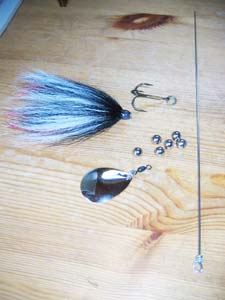
The Divani bucktailspinnerbait
Because of the demand for the building plans for this spinnerbait, I have finally decided to share it with you. You'll notice that building this spinnerbait is about as easy as it gets and yet it catches like the best of them.
Necessary items
- 1 tied and weighted coil. I refer to the article written by Thijs Knoester that deals with tying coils. You can also buy tied coils. Mine are weighted with a 1/2oz weight.
- 6 solid brass beads of 8-9mm diameter. For shallow running versions, I use 6mm diameter beads.
- 1 crane swivel with a length of about 15mm
- 1 large bucher super splitring
- 1 splitring with a diameter of 6mm
- 1 treble hook size 3/0. I use debarbed VMC conecut hooks
- 1 spinnerblade (more about those later)
- 1 piece of stainless steel wire with a diameter of 1.5mm or stainless welding wire with a diameter of 1.6mm. This has a length of 40cm.
- a pair of roundnosed pliers
- a pair of bolt cutters
- a pair of splitring pliers
The first picture shows the necessary items.
Step-by-step explanation
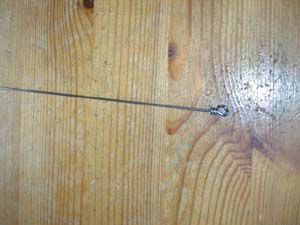
The first thing that we'll need to do, it to bend an eye on one end of the wire shaft. I would like to refer to the many articles that we have written about building spinners. About 2-3 wrappings are enough because of the solid wire. (view picture 2)
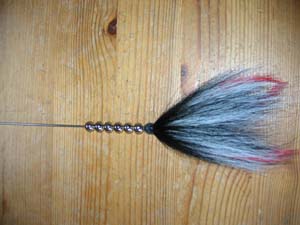
Next we slide the tied coil and then the 6 solid brass beads onto the shaft. (view picture 3)
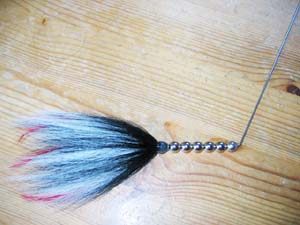
Take the pair of roundnosed pliers and bend the shaft directly behind the last bead. Bend the shaft at an angle of approximately 80° with the horizontal plane. (view picture 4)
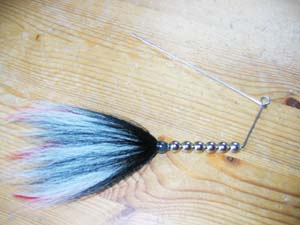
Now we proceed to bend an eye in the shaft to use as the attachment eye for the wire trace. I bend this eye at approximately 4cm above the last bead. (view picture 5)
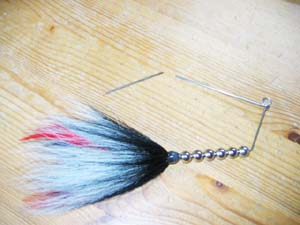
Next I measure a distance of about 8cm and I cut off the remainder of the shaft. (view picture 6)

Take your pair of roundnosed pliers again and bend the eye that will be used to attach the swivel. I grab the shaft at about 5mm from the end and turn the shaft around one leg of the roundnosed pliers. Leave the eye open so we can add the swivel. (view picture 7)
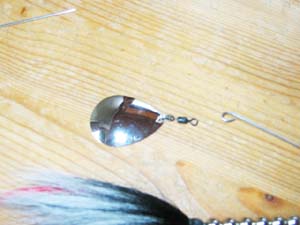
Next we'll connect the swivel, 6mm diameter splitring and blade using the pair of splitring pliers. (view picture 8)
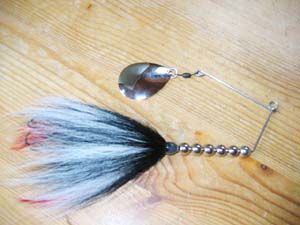
Finally we hook the swivel in the eye that we prepared in step 7 and we use a pair of roundnosed pliers to close the eye. The swivel has to be unable to get out of the eye. Add the bucher splitring ad treble to the eye that we bent in step 1 and you're ready to go! (view picture 9)
Spinnerblades
Some people asked me which blades I like to use so I'll tell you something more about that. As far as I'm concerned, colorado blades are the best for both casting and trolling. I have tried numerous variations using willow blades, french blades, fluted blades, indiana blades, ... but I keep going back to the colorado blades. Why, you ask? I haven't got the answer but the fish tell me I'm on the right track. All pike that I caught on this type of spinnerbait, grabbed a colorado bladed spinnerbait. These blades are fun to fish and they are suitable for depth control, more so than any of the blades I mentioned above.
The only thing that I don't like to use, is a tandem bladed spinnerbait. The resistance in the water of two large colorado blades just about takes the fun out of fishing for me. It's best to use a small size 5 colorado blade on the shaft, separating it from the swivel by using two or three hollow brass beads, and by adding a large size 8 willow blade or a size 7 colorado blade to the swivel.
I use these spinnerbaits for both casting and trolling and most are fitted with a size 7 colorado blade. On the smaller ones I use a blade size 6. It's easy to attain a depth of 3-4m this way. It's also the blade that I used to build the spinnerbait in this article. If I want to troll slower or reel the bait in shallower, I use a size 8 colorado blade. Because of the splitring construction, it's easy to change blade fast. A bigger blade has more resistance in the water and therefore makes the bait run shallower.
Below I added a picture of widely used spinnerblades for spinnerbaits (view picture 10). From left to right you see:
- size 8 wilgenblade
- size 8 indiana blade
- size 8 colorado blade
- size 7 colorado blade
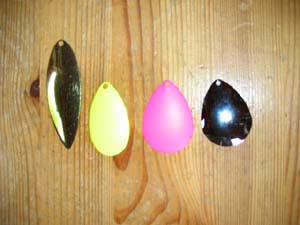
Tight lines and should you have any questions, feel free to contact me at dirk@lurebuilding.nl.











